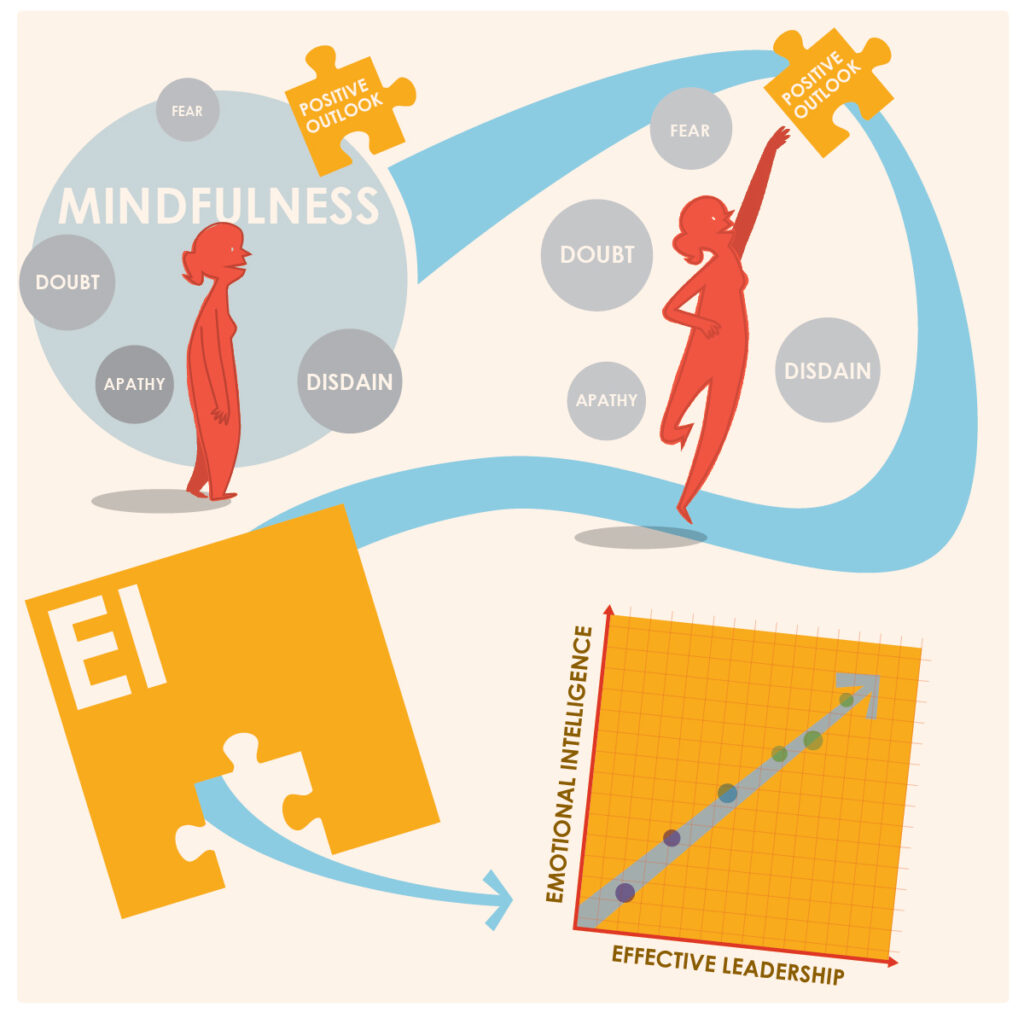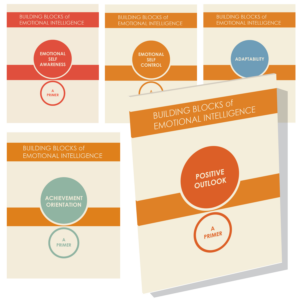

How a Positive Outlook Helps Mindful Leaders Thrive
May 31, 2017 Time to read: 4 min.
In my previous article on Achievement Orientation I touched on the way mindfulness training helps to cultivate positive emotions, and increase the ability to focus. The 42 leaders that participated in my study provided many examples of this process helping them reach significant goals, as well as repeatedly overcoming extremely challenging situations during their careers. One critical element of these successes is the Emotional and Social Intelligence Leadership Competency of Positive Outlook, which I explore in greater detail in this article.
Based on my research, there is a relationship between mindfulness and positivity, which influences leadership effectiveness via development of specific emotional intelligence competencies.

How Does Positive Outlook fit into Emotional Intelligence?
Positive Outlook is one of the competencies included in the Leadership Competency Model developed by Daniel Goleman and Richard Boyatzis. It falls under the domain of Emotional Self-Management, and is present in leaders with a stronger tendency to see the positive aspects of situations and people. A leader is identified as possessing the Positive Outlook Competency if they have:
- A dominant belief that the future holds better potential outcomes
- A tendency to focus on positive aspects of difficult circumstances
- An inclination towards positive perceptions of others
Positive outlook, along with each of the other eleven competencies, has been empirically linked to increased leadership performance through more than 62,000 assessments conducted at a variety of global organizations.
Positive Outlook in the Workplace
The leaders I interviewed made a point of emphasizing the overarching value that a positive outlook provided for their career success. These observations occurred during in-depth descriptions of how mindfulness helped them recognize the influence their reactions and beliefs have on the way they approach situations and view others. These realizations were also reported as having a profound effect on leaders by bringing their attention to how much control they actually had over the quality of their daily experiences.
How Does Positive Outlook Contribute to Leader Effectiveness?
The development of positive outlook contributes to a number of critical leadership capabilities. Examples include a solution-oriented approach to interpersonal conflict, and consciously choosing to focus on strategies for success during periods of great adversity. This development was attributed by leaders to the way mindfulness enables honest analysis of how they could have handled past challenges more effectively. Leaders described incorporating this knowledge into real-time emotional self-management activity, which helped them stop behaviors that detracted from others’ willingness to support their objectives.
Many leaders described life-altering realizations about the power of positive outlook influencing dramatic changes early in their careers. This is exemplified by a CIO, who led departments for a major US city and University, when describing how he chose to view a potentially catastrophic situation earlier in his career: “The company actually went bankrupt, but it was a great way to get out of a situation, which actually propelled my career in a big way.”
Leaders also provided many examples of mindfulness contributing to an awareness of how they could develop a more positive outlook concerning their feelings about, and interactions with, others in the workplace. This realization is summarized by a senior manager at a large US hospital network, who stated: “I understand that the people there are often making the best decisions they know how to make, doing the best they can.”
How Can You Begin to Develop Positive Outlook?
As discussed in my article on Emotional Self-Awareness, mindfulness contributes to a heightened level of both emotional self-awareness and meta awareness (conscious awareness of what you are aware of). This helps you identify the relationship between events and your mood or attitude about them, and gain a better understanding of how you tend to view experiences. With this knowledge you can begin to identify whether or not your approach to situations or interpersonal relationships is more negative – and therefore less productive – than it could be.
Incorporating this personal insight, you can begin to increase your capacity for positive outlook by investing time in the following activities:
- Reflect on your attitude and expectations relating to past events and interactions
- Observe your emotional and physiological reactions to anticipated events
- Refine your ability to observe your emotional states and reactions in real-time
- Learn to identify the way your beliefs subconsciously influence experiences
These are some of the skills developed or enhanced by mindfulness training.
The information you obtain from these activities will play a crucial role in helping you identify opportunities for improving positive outlook. These results can materialize in a number of ways, including through greater Emotional Self-Control, and/or understanding the value of activities that leverage your new level of self-awareness.
For example, leaders reported setting aside time to focus on planning when they are in a positive mental state. They also described reserving time before important meetings to think through the best way to communicate critical details, and strategies to proactively resolve potential conflicts. Finally, leaders also described assuming a success-oriented approach to engaging in difficult conversations and activities once they began to view them as challenges instead of obstacles.
Give it a try, keep track of your results, and then continue to build upon them over time.
Recommended Reading:
 Our new primer series is written by Daniel Goleman and fellow thought leaders in the field of Emotional Intelligence and research. The following are available now:
Our new primer series is written by Daniel Goleman and fellow thought leaders in the field of Emotional Intelligence and research. The following are available now:
Emotional Self-Awareness, Emotional Self-Control, Adaptability, Achievement Orientation, and Positive Outlook.
For more in-depth insights, see the Crucial Competence video series.







